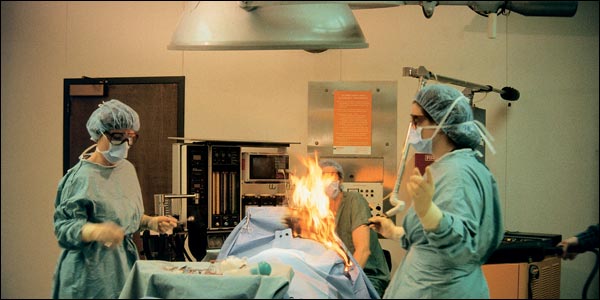Safety in the Operating Room: Preventing Surgical Fires
If you are a healthcare professional, then you already know safety is the main goal for any procedure done in an operating room. That is why it is important to understand what a surgical fire is, what causes it, and how to reduce the risk and/or contain it. Medical products used in surgical procedures such as: medical gases, alcohol-base skin preparation agents, ESU’s, lasers, and fiber optic light sources all have one thing in common… flammability. A surgical fire is a rare event that can cause serious injuries, and death. A surgical fire can start at any time in a medical facility when all three of these elements are present:
1. Ignition source (ESU, lasers, fiber optic light sources, etc.)
2. Fuel source (surgical drapes, alcohol-based skin prep agents, patients, etc.)
3. Oxidizers (oxygen, nitrous oxide, room air, etc.)
According to the FDA, the ECRI Institute estimates about 550 – 650 surgical fires occur in the United States per year, which are all preventable. The FDA also states that most surgical fires occur in oxygen-enriched environments, when the concentration of oxygen is greater than in ordinary room air, which also applies to patients. To reduce the risk of surgical fires, a person should follow these guidelines:
1. Conduct a fire risk assessment at the beginning of each procedure.
2. Use supplemental oxygen safely
3. Use alcohol-based (flammable) skin preparation agents safely
4. Use devices and other surgical equipment safely
5. Encourage communication among members of your surgical team
6. Plan how to manage a surgical fire.
7. Increase awareness of factors that contribute to surgical fires
8. Disseminate surgical fire prevention tools
9. Promote risk reduction practices through the healthcare community
For more information on surgical fires, see these helpful resources from the ECRI & FDA:
Extinguishing A Surgical Fire Emergency Procedure
Surgical Fire Prevention
FDA Tips for Preventing Surgical Fires

Sources:
"Patient Safety, Quality and Risk Management." Surgical Fire Prevention. N.p., n.d. Web. 22 July 2014. <https://www.ecri.org/surgical_fires>.
"U.S. Food and Drug Administration." Preventing Surgical Fires: FDA Safety Communication. N.p., 13 Oct. 2011. Web. 22 July 2014. <http://www.fda.gov/MedicalDevices/Safety/AlertsandNotices/ucm275189.htm>.
Durso, Fred. "Operation Fire Safety." National Fire Protection Association . Version January/Feburary. NFPA Journal, 1 Jan. 2012. Web. 24 July 2014. <http://www.nfpa.org /newsandpublications/nfpa-journal/2012/january-february-2012/features/operation- fire-safety>.